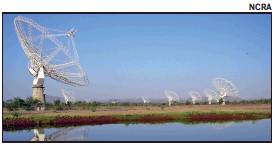Tata Institute of Fundamental Research
This is a collection of articles archived for the excellence of their content. |
National Centre for Radio Astrophysics
Galaxy TGSS1530/ 2018
Aayush Saxena, a researcher at a Dutch observatory, and his colleagues from various countries have found the most distant radio galaxy yet discovered — 12 billion light-years from Earth — with initial data derived from a sky survey done at India’s Giant Metrewave Radio Telescope (GMRT) seven years ago. GMRT is an array of 30 fully steerable parabolic radio telescopes of 45m diametre located in Khodad, about 60km from Pune, and operated by Tata Institute of Fundamental Research’s National Centre for Radio Astrophysics.
Saxena and his colleagues from institutes in Leiden (the Netherlands), Brazil, Italy and the UK discovered the galaxy in June, and named it TGSS1530. The galaxy was perceived as it appeared when the universe was only 800 million years old, just 7% of its current age, stated a study accepted by the journal, Monthly Notices, of the Royal Astronomical Society. “GMRT had done an all-sky survey at 150mghz around seven years ago. This was the lowest frequency at which a survey has been done. The survey is like a gold mine and people are discovering new things from it,” GMRT observatory dean Yashwant Gupta told TOI.
Radio galaxies are galaxies that contain a super-massive black hole of millions of solar mass and emit copious amount of radio waves.
